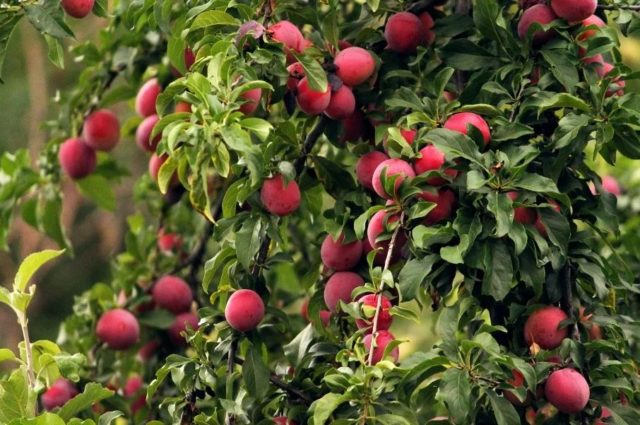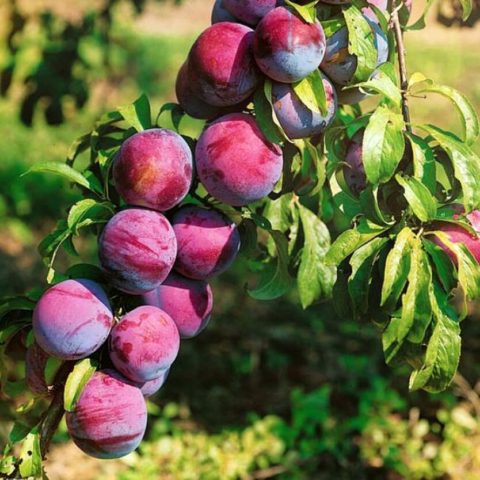Content
Cherry plum is a common fruit plant that belongs to the Plum genus. At the moment, several dozen hybrid varieties have been bred. The aromatic cherry plum Nectarine is recognized as one of the highest-yielding. At the same time, the plant is considered undemanding and easy to care for.
History of selection
Hybrid cherry plum or Russian plum is the result of the directed activity of scientists. This variety was bred at the Crimean experimental breeding station. The variety was obtained as a result of hybridization of wild cherry plum and different types of Chinese plum.
Description of the cherry plum variety Nectarine aromatic
The Russian plum is a low-growing tree. The average height of the hybrid cherry plum Nectarine aromatic is from 1 to 1.8 m. The tree has a rounded spreading crown. This cherry plum variety is characterized by a low growth rate.

Annual growth of the Nectarine aromatic variety is up to 15 cm
The trunk of the Russian plum is erect. It is covered with smooth gray bark with a small number of lentils. The tree is highly branched. Medium-sized, elliptical leaves with a pointed edge grow densely on the side shoots. The surface of the plate is dark green, without lint, slightly shiny.
Characteristics
The aromatic Nectarine plum has many advantages over other hybrid varieties. You can verify this by familiarizing yourself with the main characteristics of such cherry plum.
Drought resistance
The Nectarine aromatic variety is practically insensitive to moisture deficiency. A short-term lack of watering does not affect the condition of the cherry plum and productivity indicators. Only a very prolonged lack of water can cause harm. Otherwise, the plant tolerates summer drought well, accompanied by low air and soil humidity.
Winter hardiness of cherry plum Nectarine aromatic
The variety is resistant to low temperatures. After obtaining the hybrid, nectarine plum was grown in different regions of the Russian Federation in order to determine sensitivity to frost. The variety showed exceptional frost resistance. Russian plum tolerates low temperatures well without shelter. The exception is first-year trees, which are recommended to be closed for the winter.
Pollinators of cherry plum Nectarine aromatic
The presented variety is self-fertile. Pollinators are not required for harvesting.The need for them may arise only in order to increase fruiting if the tree grows in poor soil devoid of nutrients.
The following varieties of plums are used as pollinators:
- greengage;
- red early ripening;
- Moscow Hungarian;
- red ball.
By planting such plants next to the hybrid cherry plum Nectarine aromatic, you can significantly increase the yield from one tree. The taste of the fruit does not deteriorate.
Flowering period and ripening time
The budding of the aromatic cherry plum Nectarine occurs at the end of March. Flowering begins in early to mid-April and lasts up to 2 weeks. During this period, the tree is covered with numerous five-petaled white flowers with a slight pink tint.
Nectarine aromatic is a mid-season variety. Fruit formation begins in late July or early August. They fully ripen at the end of summer, less often at the beginning of autumn.
Productivity, fruiting
Alycha Nectarine aromatic is valued for its fruits. Plums grow large, weighing 45-70 g. They have blue skin and are covered with pollen.
The pulp of plums is yellow and fibrous. The density and juiciness of the fruit is average. The taste is sweet and sour, reminiscent of nectarine. Inside there is a bone that is easily separated from the pulp.

From one hybrid cherry plum tree you can collect up to 50 kg of fruits
Nectarine aromatic has a very high yield. A minimum of 25 kg of plums is collected from one plant.
Area of application of fruits
Due to its pleasant taste, Nectarine aromatic plum is consumed fresh. It is also used in the preparation of fillings for baking and canning.Nectarine plum is not very sweet, but is good for jam and confiture.
Cherry plum is often used for summer refreshing drinks. Nectarine plum is added to compotes and fruit drinks.
Resistance to diseases and pests
Almost all varieties of hybrid cherry plum are characterized by low sensitivity to adverse factors and infections. The aromatic nectarine plum is resistant to an overwhelming number of diseases, including those caused by excess moisture and stagnation of fluid in the roots.
Hybrid cherry plum varieties are also not sensitive to almost all types of pests. The exception is the caterpillars of the American butterfly, which infect any fruit trees. Ripe fruits hanging on branches can attract wasps and moths. To avoid crop loss, plums must be picked from the tree in a timely manner, as they ripen.
Advantages and disadvantages
The Nectarine aromatic variety has gained wide popularity among beginners and experienced gardeners. This is explained by the many advantages that such cherry plum has.
These include:
- high productivity;
- resistance to frost, drought;
- ease of care;
- no need for pollinators;
- good taste of fruits;
- possibility of propagation by cuttings;
- resistance to diseases and pests.

To bear fruit, the Russian plum does not require sprinkling or deep soil moisture.
The main disadvantage of the variety is the slow growth rate of the tree. The disadvantages include the low strength of the branches. It is not uncommon for them to break under the weight of the fruit.
Features of planting plum Nectarine aromatic
The described variety is resistant to unfavorable conditions. However, to obtain a bountiful harvest, you need to follow the growing technology. First of all, the procedure and rules for planting plants in open ground are determined.
Recommended timing
The decisive factor when choosing a planting date is the climatic features of the region. In the south, it is recommended to plant hybrid cherry plum in the fall. When planted before winter, the tree adapts better to new conditions and tolerates the first winter in open ground well.
In the regions of the middle zone, as well as in places with a more severe climate, it is recommended to plant Nectarine aromatic cherry plum in the spring. Planting is usually carried out in early to mid-April. During this period, the constant temperature of the surface layer of soil reaches 10 degrees, which is considered the optimal indicator for fruit trees.
Choosing a suitable location
Sunny areas are best suited for hybrid cherry plum. Planting in partial shade is allowed. It is not recommended to plant fruit trees in shaded areas, since the lack of light can negatively affect the ripening time of fruits.
Experienced gardeners recommend planting the Nectarine aromatic variety on small hills. In lowlands, trees can be drowned by groundwater. Short-term stagnation of liquid is harmless, but if the outflow of water from the soil is disrupted for a long time, rotting of the roots may begin.
What crops can and cannot be planted next to cherry plum
When choosing plants to plant with the Russian plum, there are a number of criteria to consider. This directly affects whether a shrub or tree can be planted next to the cherry plum.
Main criteria:
- soil composition requirements;
- need for sunlight;
- sensitivity to winds;
- prone to diseases and pests.
Since nectarine aromatic cherry plum is a light-loving plant, it cannot be planted near tall trees that will block access to sunlight. The depth of the root system should also be taken into account. In hybrid varieties they are located on average 30-40 cm underground.
Next to the cherry plum you can plant:
- wild varieties of plums;
- another cherry plum;
- cherries and sweet cherries;
- apricot;
- Walnut;
- mulberries.
This proximity does not have a negative effect on fruit plants. Trees and shrubs coexist normally without harming each other.
It is not recommended to plant next to cherry plum:
- coniferous trees and shrubs;
- peach;
- gooseberry;
- currants;
- raspberries;
- quince;
- tomatoes;
- apple trees, pears with large fruits.
Maintaining the proximity between cherry plum and other plants is an important factor affecting productivity. However, the Nectarine aromatic variety is almost insensitive to the close proximity of other types of fruit trees.
Selection and preparation of planting material
For planting in open ground, annual seedlings are used. Before planting, you need to make sure that there are no damage or signs of death on the roots. The foliage of the plant should be abundant.

A sign of disease in a cherry plum seedling is damage to the bark
You can grow the aromatic cherry plum Nectarine yourself from a seed. However, this is a long and labor-intensive process. This also sometimes leads to the plant losing its varietal characteristics.
Landing algorithm
The initial stage is site preparation. Weeds are removed from the selected location.The soil is dug to a depth of 25-20 cm. If the soil is poor, compost, dry manure or other organic fertilizers can be added to it. This is done 3-4 weeks before the expected planting date of the cherry plum.
Landing algorithm:
- Prepare a planting hole, depth 50-60 cm.
- Place a layer of expanded clay, small crushed stone or pebbles at the bottom for drainage.
- Sprinkle with fresh soil.
- Place the seedling inside.
- Spread the roots, pointing them to the sides.
- Cover with a mixture of turf and leaf soil combined with compost.
- Compact the surface layer of soil to stabilize the seedling.
- Water the tree with water.
In the first year after planting in the ground, cherry plums, as a rule, do not bear fruit. You can get a real harvest next summer.
Subsequent care of the crop
Hybrid cherry plum is unpretentious. Care comes down to a few simple procedures.
The main ones:
- Pruning dried shoots in spring.
- Loosening and mulching the soil around the tree 1-2 times a month.
- Watering - 20-25 liters of water for each tree 1-2 times a week.
- Removing root shoots.
- Installing supports to prevent damage to branches due to the weight of the fruit.
- Apply phosphorus-potassium fertilizer once in July.
In autumn, Nectarina aromatic cherry plum is fed with organic matter. The bark is cleared of dying particles. Fallen leaves and fruit remains are collected and disposed of.
Diseases and pests, methods of control and prevention
Descriptions and photos of plum Nectarine aromatic indicate that the variety is extremely rarely affected by infections and insects.Therefore, care involves a small set of measures aimed at protecting the fruit tree.
When signs of disease appear, the cherry plum is sprayed with a complex fungicide. Preventive treatment is possible. It is carried out in April or early May when persistent warming occurs.

Insecticide treatment protects against most types of fruit-eating insects
To protect against pests and diseases, it is recommended to spray the tree with a solution of copper sulfate. For preventive purposes, the trunk and lower branches of the cherry plum are whitewashed. To repel insects, the plant can be sprayed with garlic infusion. The soil around the tree is mulched with tobacco ash.
Conclusion
Cherry plum Nectarine aromatic is a common hybrid variety that is in demand among gardeners. This variety is characterized by low sensitivity to harmful factors. At the same time, nectarine cherry plum produces a bountiful harvest of delicious, aromatic fruits. Planting and caring for such a plant does not require much effort.








